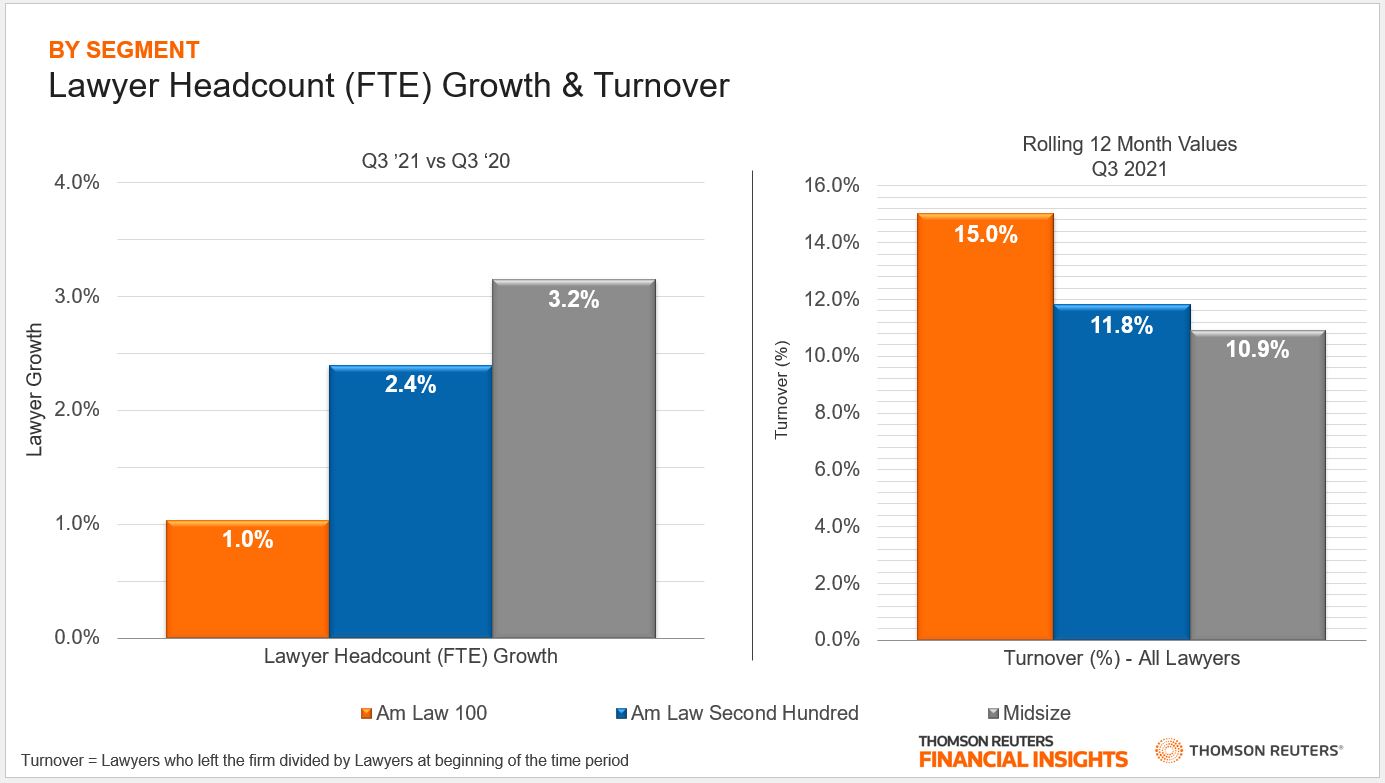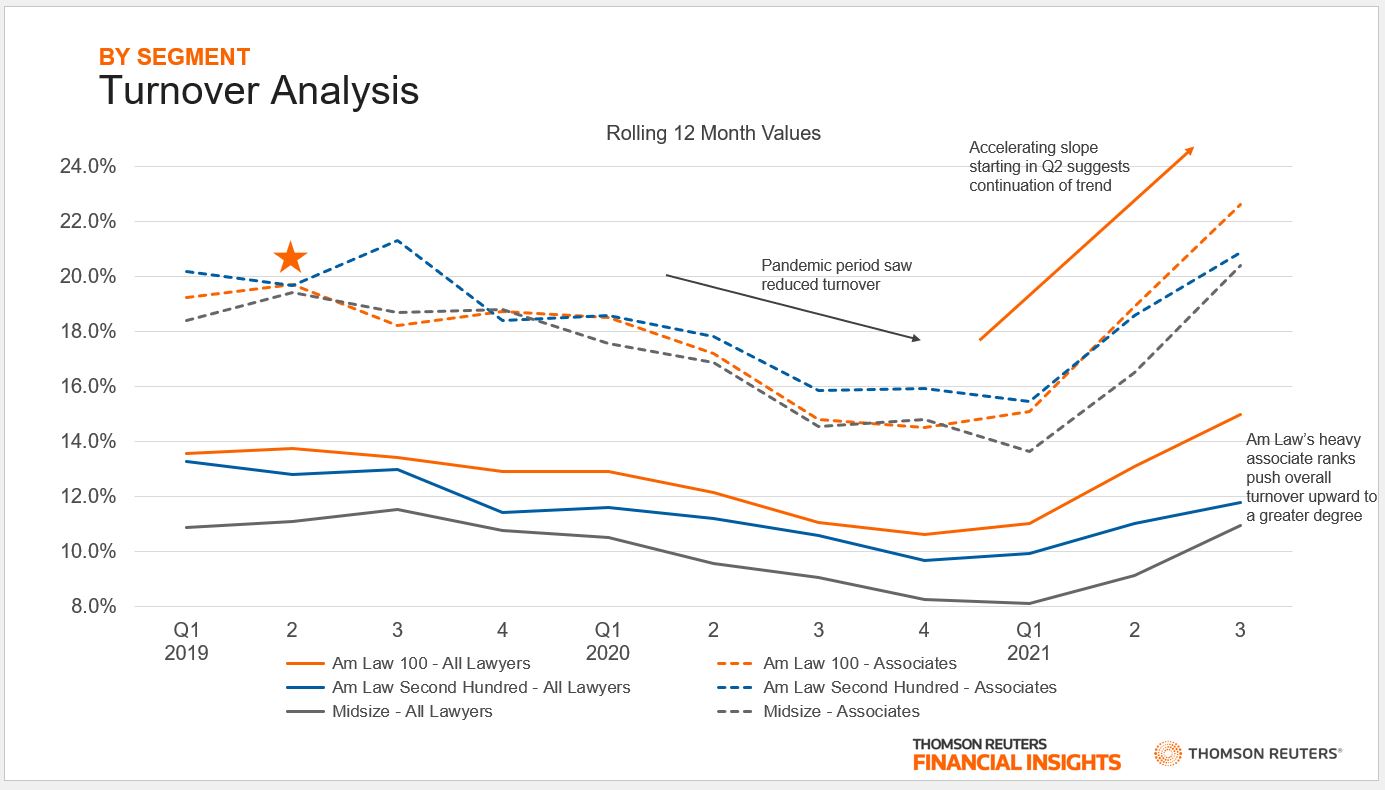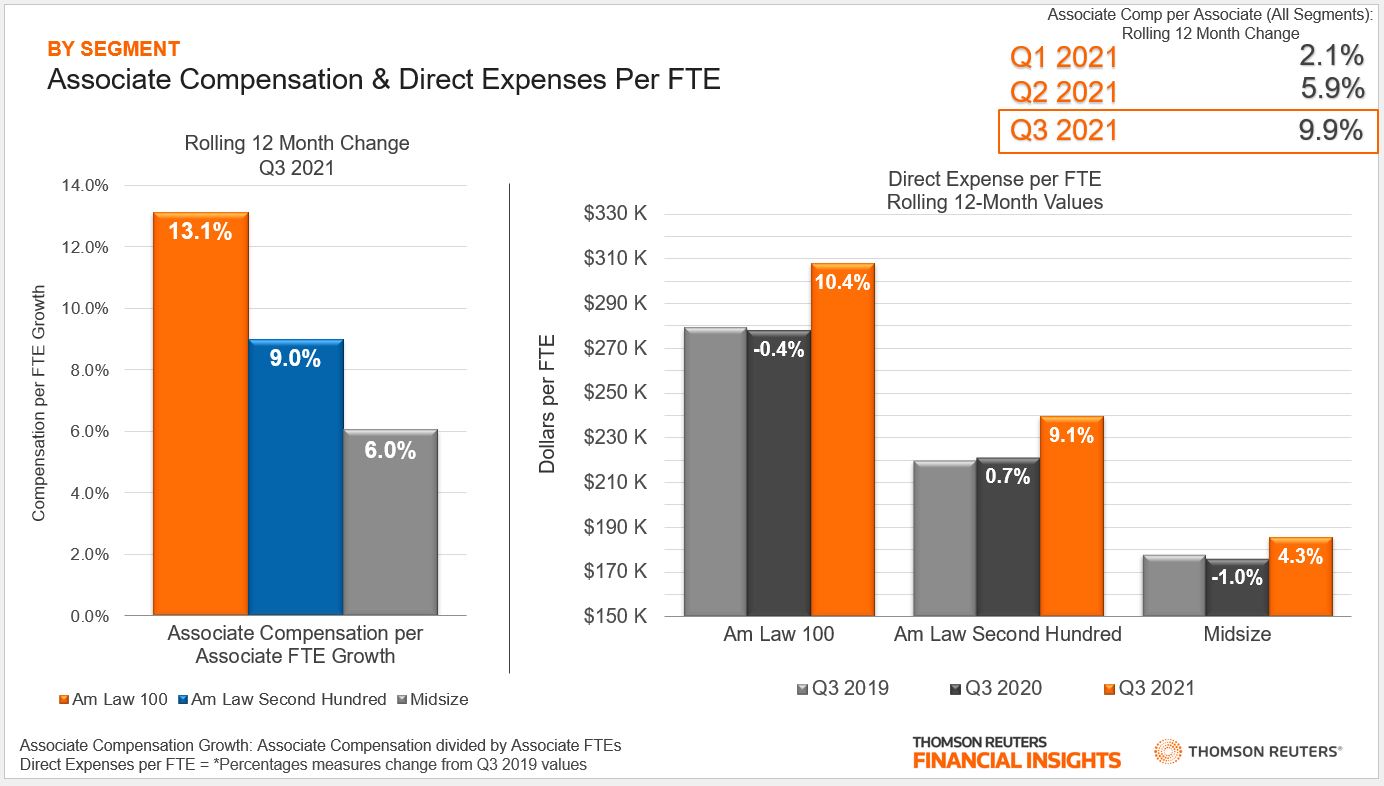Will lawyer turnover and rising talent expenses spoil an otherwise swell party for the legal industry?
When we released the third quarter’s Thomson Reuters Peer Monitor Index (PMI) with a score higher than any seen between 2010 and 2020, one would expect it to reflect an industry enjoying the best of times. Overall legal demand was on average up 4.4% over last year and up 0.8% compared to a strong Q3 2019, empowered by a surging transactional practice so hot it threatened to boil over beyond many firms’ capacity to meet it. At the same time, rate growth was healthy, up 3.7% on average over 2020.
Certainly, if one factors in that these numbers are coming in the midst of an ongoing global crisis, which only a year ago seemed an existential threat to some law firms, the cause for celebration only seems to increase.
Yet, the PMI’s results held another, more cautious message that tamped down any overly exuberant expectations. The Index had fallen from its all-time high of 84, notched just one quarter earlier in Q2 2021, and was pulled down by a 7.2% surge in direct expenses. Despite the lavish earnings of the industry in the third quarter, concern swirled around a war for talent. Turnover, suppressed in Q3 2020 by the pandemic, reached 13.8% in Q3 2021. The legal industry, facing burnout from its red-hot transactional practices, broke out into a bidding war. In Q3 2021, associate compensation growth increased by 9.9% compared to the year previously. As we look further into this subject however, it appears that not all segments fared equally.

In the beginning of the talent war, media reports quickly circulated about a concerted push by Am Law 100 firms to hire fresh lawyers, offering increasingly exorbitant salaries to lure them in. These reports would continue to state that, while these efforts brought many new lawyers into firms, this new blood was not enough to stem the tide of those lawyers walking back out the door. (And we can confirm these reports with our own data as shown in the graph above.)
In fact, it’s clear that one reason Am Law 100 firms are experiencing dramatically lower net headcount growth compared to their counterparts in other segments is because of their significantly higher turnover. While the average Midsize law firm saw 10.9% turnover, Am Law 100 firms experienced 15.0%.
The source of this discrepancy is the structure of Am Law 100 firms. These larger law firms typically have dramatically higher leverage. In other words, a larger proportion of their law firm consists of associates. Am Law 100 firms on average have 1.91 associates per equity partner in 2021; while Midsize firms had a leverage ratio of 0.84, less than one associate per equity partner. As such, Am Law 100 firms are far more susceptible to fluctuations in the associate talent market.

Each segment is seeing rising associate turnover in 2021 and as of Q3, all segments’ turnover rate is above 20%. This level is higher than the turnover seen during pre-pandemic 2019 (aside from a slight bump for the Am Law Second Hundred firms in Q3 2019). While this current level of turnover is historically high, the worrying part is that the metric looks like it has room to continue higher. The graph above shows a rolling 12-month analysis of turnover, smoothing out the influence of seasonality and other anomalies. Considering the fact that the “Great Resignation” broke out in Q2 2021, we can expect these numbers to trend upward for some time. Indeed, Am Law 100 firms so far have and will most likely continue to lead this ascent.
Law firms have previously solved this problem by pulling the so-called salary increase lever, hoping to employ this relatively easy solution to defend against a recognized threat. Am Law 100 firms seem to be especially willing to take this type of action.

Because the rising associate salaries shown in the above graphic are highly consolidated among Am Law 100 firms, this heavily suggests that these firms were much more likely to match market salaries for associates. Am Law 100 firms are experiencing nearly double the growth rate that Midsize firms are witnessing in salary growth. As stated previously, these large firms and their leverage structure translates to significantly higher increases in their overall direct expense per lawyer.
In Q3 2021, for example, Am Law 100 firms on average experienced an increase in direct expenses per FTE of 10.4% compared to Q3 2019, with salaries and benefits culminating in overall direct expenses topping $300,000, spread out over each lawyer full-time equivalent. The Am Law Second Hundred — with leverage in-between that of Am Law 100 and Midsize firms — saw a somewhat diminished increase in direct expenses in both percentage and absolute terms. Midsize rounded out the pack with 4.3% direct expense per FTE growth compared to pre-pandemic levels.
However, it would be wise to view these figures with some caution, as the Q3 2020 figures encapsulate some of the reduced compensation which firms enacted early in the pandemic as a survival measure and also isolate the figures from the Q4 2020’s bonuses. In addition, those year-end bonuses from 2020 and early 2021 continue to amplify direct expense levels in our most recent period. In fact, one could view the 10% increase in growth for Am Law 100 firms as a type of catch-up pay, smoothing this difference out as a more reasonable 5% per year since 2019. And the same can be said for other segments.
While it is impossible to know what the turnover rate would have been like for Am Law 100 firms if they hadn’t pulled the salary increase lever, it is notable that those increases haven’t halted the deterioration of their workforce. Other segments, while increasing their associate compensation by far less are still seeing higher retention. This speaks to how workplace culture matters — which can be more difficult to cultivate at larger firms — and how throwing money at a problem isn’t always the best solution.
Even as many observers are focused on direct compensation growth, revenue is accelerating to a greater degree due to the surge in corporate work. In addition, the potential of the resurging COVID-19 virus has continued to push back the return-to-office plans of both law firms and their corporate clients. This, of course, continues to suppress overhead growth.
Further, both of these factors continue to outweigh direct expense growth in the short-term as firms look to have continued growth in profit on top of 2020’s incredible results. How long the pressures of the Great Resignation will last is unanswerable, as is its ultimate cost to firms. So far, this phenomenon seems set to be the defining challenge of 2022, pushing those larger, more heavily leveraged firms to continue directing their ship towards these unknown waters.







